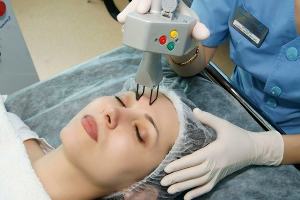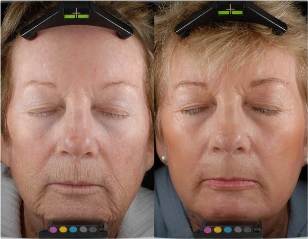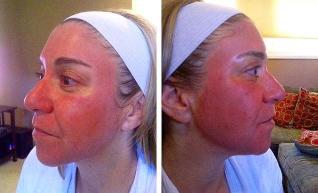
Fractional CO2 laser is an innovative technology in the field of aesthetic medicine and cosmetology, which allows you to restore youthful and smooth skin, and eliminate scars, scars, stretch marks, etc. Unpleasant appearance defects.However, its use has caused much controversy. This skin care method has both supporters (usually surgeons) and opponents represented by dermatologists and beauticians.
What is this process? What impact will it have? Why does it cause such conflicting opinions? We will tell you everything in detail and answer all your questions.
Fractional laser: description of the program and its functions
In cosmetology and aesthetic medicine, two types of fractional lasers are used: lower power levels and shorter wavelengths and CO2 lasers, which use higher laser power and reach deeper layers of the skin.
Fractional laser treatment produces the following results:
- Revival.
- Improve the structure of the epidermis.
- Reduce stretch marks, scars and scars.
- Remove age spots.
- Shrink pores.
- The skin tightens.
- Skin tone alignment.
- activates the skin by stimulating blood circulation in the capillaries, thereby absorbing more oxygen, which has a positive effect on the appearance of the skin.

The most popular is to use CO2 laser for partial repair, which has excellent results. Due to the increased production of elastin and collagen, the skin regains firmness and elasticity, wrinkles are smoothed, and skin tone becomes even. With the lifting effect, the previous contour of the face is restored-it becomes clearer and clearer, the sagging of the chin and cheeks is eliminated, and the nasolabial fold becomes smooth.
In the photo, you can compare the skin condition of the patient before and after the fractional laser:
In this process, when a laser head is activated, a laser beam working on 20-25% of its treatment area is used to treat the skin. The laser beams are distributed at a distance from each other in the vertical and horizontal directions. The number of rays and the treatment depth of skin tissue depend on the settings of the laser parameters in a given skin and a given area of the head used. Choose them according to the characteristics of the patient's skin, the treatment area and the type of problem to be solved.
The fractional wavelength of the laser is about 1550 nm. This causes the beam to penetrate into the skin to a depth of 2 mm. It stimulates the production of collagen and elastin in the skin tissue, thereby achieving a rejuvenating effect and reducing scars and scars. Moreover, due to this process, the regeneration function of the epidermis increases.
In order to get the desired result, you should have 2-6 courses of treatment. The doctor will tell you the exact phone number.The duration of the process is 40-100 minutes (processing time depends on many parameters).
Although it works well, the process can still cause a lot of negative emotions, especially for those who were not informed at the beginning and were disappointed by the discomfort and pain during the process.
Instructions for CO2 fractional laser operation
The effects of some CO2 laser treatments are very similar. The main difference is that the wavelength reaches about 10, 000 nm.This is an ablation technique used to reduce large scars or age spots and perform a powerful facelift.
The procedure is performed using anesthesia. To do this, apply anesthetic cream to the treated area of the skin, or take analgesics by mouth.
Although the pain is relieved, the patient has little comfort when treating the skin with the laser beam. The skin is swollen, red, tight and dry, and often accompanied by itching. This feeling disappeared after about 2 days and was replaced by the peeling of the epidermis, which may become darker with the change of skin color.
Rosacea or redness did not completely go away after about 2 weeks.If the recovery period with laser laser treatment lasts 1-3 days, the recovery after CO2 low-dose laser treatment will take 4-7 days.But in most cases, this discomfort will last longer-up to 2 weeks.
In order to obtain results, it is necessary to perform 3 to 6 operations every 3-6 weeks.Only 3-6 months after surgery, the results caused by the rearrangement of collagen fibers can be observed. Therefore, CO2 fractional laser skin repair is absolutely only suitable for those very patient people who are looking for fast results.
Er fractional laser
The difference between fraction laser and CO2 laser is lower power and shorter beam-the wavelength is 1064-2940 nm. It is safer and softer on the skin, and can also provide targeted treatment for specific areas without affecting the surrounding tissues.
It is used on delicate skin areas of the body: neck, arms, sternum.

Rehabilitation and nursing after surgery
The recovery period is 4-5 days. After the operation, the skin may immediately become red, itchy, peeling, and look unattractive. Therefore, it is recommended to cancel important matters within a few days after the meeting, and then spend it at home to rest. But it should be remembered that all the consequences of this process will only disappear completely after about 2 weeks.
Skin care after surgery plays an important role in the result of fractional laser.If you want her to look good, pay special attention to her in the first few days after surgery. It is necessary to ensure that its moisture reaches the optimal level. After the operation, the doctor will provide you with recommendations for moisturizers to use after the operation.
It is important to remember that in the first day after training, you should avoid using sun rays, as they may damage new cells and cause skin discoloration. In addition, during the first month, you should not take hot baths, visit saunas, swimming pools, swim in open water, and sunbathe purposefully.
Another post-processing guideline is to allow the skin to regenerate at its own rate. You should not specifically increase the peeling of the skin, peel off the peeled area, which may cause the completely opposite effect than expected.
Indications and contraindications of CO2 fractional laser
The main instructions for this process are:</ zxp>
- The skin is loose.
- Express age-related changes.
- Deterioration of facial contours.
- Wrinkles.
- Large pores.
- Scars, stretch marks, acne scars.
- Pigmented spots.
- Reduce skin firmness.
- A benign formation.
The following are the contraindications of fractional laser:
- Pregnant.
- Cancer.
- Inflammation.
- Skin infection.
- Psoriasis.
- Fresh tan.
- Chronic diseases in the acute phase.
- Oncology.
- Diabetes.
- Kelloid tends.
- Thrombosis.
Considering all the advantages and disadvantages, it should be emphasized that fractional laser treatment can only be performed after consulting a doctor and thoroughly understanding the procedure.You should fully understand the waiting situation during the meeting and the extent to which skin blemishes can be improved.
It should be assumed that despite the use of painkillers, the procedure is uncomfortable and even painful, and the results only appear after a few months. Therefore, it is not suitable for people who are impatient and have a low pain threshold. Considering the high cost of the procedure (depending on the area being treated and the pricing policy of the beauty center), a decision can only be made after carefully considering everything.
CO2 Fraction Laser Review
Most comments on fractional laser surgery are positive. Those people noticed its high efficiency: it removes scars and scars, makes the skin smooth, improves the puffiness and texture of the skin, reduces pigmentation, and makes the skin tone even. But at the same time, praise and complaint coexist. The high price, the pain of the operation, the long waiting time for results, severe itching and redness after the treatment is over-these are the moments that lead to patient dissatisfaction.
It should be remembered that the effect depends largely on the professional level of the experts who will perform the procedure. Therefore, if you decide to use a small dose of laser for skin resurfacing or skin rejuvenation, be very careful when choosing a beautician. Contact with an inexperienced doctor may cause the effect to be completely opposite to the expected effect-it does not improve the skin, but worsens the skin, and it takes a long time to get treatment.





















